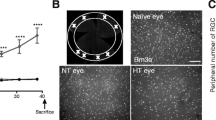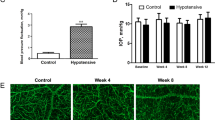Abstract
Ocular hypertension is a symptom of a glaucomatous condition characterized by a severe vision decrease. Blindness caused by the apoptotic death of the retinal ganglion cells and of the astrocytes of the optic nerve may eventually result. Experimental hypertension was induced by inoculation of methylcellulose in the anterior chamber. Chromatin staining, TUNEL assay, and inter-nucleosomal DNA fragmentation observed in retina and optic nerve strongly suggest that hypertension causes apoptosis. Immunolocalization of the fibrillary acidic glial protein, specific of cell stress, and caspase-3 in the same tissues, further support this mode of cell death. Activation of the ubiquitin dependant proteolytic system was also observed. Protection from apoptosis exerted by administration of the peroxide scavenger trolox, suggests that the apoptotic pathway is activated by an oxidative stress. The data presented here show that the experimental hypertensive insult induces degenerative and apoptotic events comparable to those observed in human glaucoma.







Similar content being viewed by others
References
Quigley HA (1987) Reappraisal of the mechanism of glaucomatous optic nerve damage. Eye 1:318–322
De Gregorio F, Pecori-Giraldi J, De Stefano C, Virno M (1997) Correlation between ocular hypertension induced by ibopamine and perimetric defect in primary open angle glaucoma. Eur J Ophthalmol 7:152–155
Friedman DS, Wilson MR, Liebmann JM, Fechtner RD, Weinreb RN (2004) An evidence based assessment of risk factors for the progression of ocular hypertension and glaucoma. Am J Ophthalmol Rev 138:19–31
Quigley HA, Enger C, Katz J, Sommer A, Scott R, Gilbert D (1994) Risk factors for the development of glaucomatous visual field loss in ocular hypertension. Arch Ophthalmol 112:644–649
Quigley HA, McKinnon SJ, Zack DJ, Pease ME, Kerrigan-Baumrind LA, Kerrigan FD, Mitchell RS (2000) Retrograde axonal trasport of BDNF in retinal ganglion cell is blocked by acute IOP elevation in rat. Invest Ophthalmol Vis Sci 41:3460–3466
Sommers A, Tielsh JM, Katz J (1991) Relationship between intraocular pressure and primary open angle glaucoma among white and black Americans. Arch Ophthalmol 109:1090–1095
Wax MB, Tezel G, Kobayashi S, Hernandez MR (2000) Responses of different cells lines from ocular tissues to elevated hydrostatic pressure. Br J Ophthalmol 84:423–428
Eddleston M, Mucke L (1993) Molecular profile of reactive astrocytes-implications for their role in neurologic disease. Neuroscience 54:15–36
Barnett NL, Pow DV, Bull ND (2001) Differential perturbation of neuronal and glial glutamate transport system in retinal ischemia. Neurochem Int 39:291–299
McKinnon SJ (1997) Glaucoma, apoptosis and neuroprotection. Curr Opin Ophthalmol 8:28–37
Quigley HA, Nickells RW, Kerrigan LA, Pease ME, Thibault DJ, Zack DJ (1995) Retinal ganglion cell death in experimental glaucoma and after axotomy occurs by apoptosis. Invest Ophthalmol Vis Sci 36:374–386
Noremberg MD (1994) Astrocyte responses to CNS injury. J Neuropatol Exp Neurol 3:213–220
Hernandez MR, Pena JD (1997) The optic nerve head in glaucomatous optic neuropathy. Arch Ophthalmol 115:389–395
Ye H, Hernandez MR (1995) Heterogeneity of astrocytes in human optic nerve head. J Comp Neurol 4:441–452
Ricard CS, Kobayashi S, Pena JDO, Salvador-Silva M, Agapova O, Hernandez MR (2000) Selective expression of neuronal cell adhesion molecule (NCAM)-180 in optic nerve head astrocytes exposed to elevated hydrostatic pressure in vitro. Mol Brain Res 81:62–79
Varela HJ, Hernandez MR (1997) Astrocyte responses in human optic nerve head with primary open angle glaucoma. Journal of glaucoma 6:303–313
Lieth E, Barber AJ, Xu B (1998) Glial reactivity and impaired glutamate metabolism in short term experimantal diabetic retinopathy. Diabetes 47:815–820
Mizutani M, Gerhardinger C, Lorenzi M (1998) Müller cell changes in human diabetic retinophahaty. Diabetes 47:445–449
Erickson PA, Fisher SK, Guerin CJ, Anderson DH, Kaska DD (1987) Glial fibrillary acidic protein increases in Müller cells after retinal detachment. Exp Eye Res 44:37–48
Guidry C, Medeiros NE, Curcio CA (2002) Phenotypic variation of retinal pigment epithelium in age-related macular degeneration. Invest Ophthalmol Vis Sci 43:266–273
Tanihara H, Hangai M, Sawaguchi S, Abe H, Kageyama M, Nakazawa F, Shirasawa E, Honda Y (1997) Up-regulation of glial fibrillary acidic protein in the retina of primate eyes with experimental glaucoma. Arch Ophthalmol 115:752–756
Wang X, Tay SSW, Ng YK (2000) An immunohistochemical study of neuronal and glial cell reaction in retina of rats with experimental glaucoma. Exp Brain Res 132:476–484
Wang L, Cioffi A, Dong J, Fortune B (2002) Immunohistologic evidence for retinal glial cell changes in human glaucoma. Invest Ophthalmol Vis Sci 43:1088–1094
Yuan L, Neufeld AH (2000) Tumor necrosis factor-alpha: a potentially neurodestructive cytokine produced by glia in the human glaucomatous optic nerve head. Glia 32:42–50
Bonfoco E, Kranic D, Ankarcrona M, Nicotera P, Lipton SA (1995) Apoptosis and necrosis: two distinct event induced respective by mild and intense insult with NMDA or nitric oxide/superosside in cortical cell cultures. Proc Natl Acad Sci 92:7162–7166
Cotinet A, Goureau O, Hicks D (1997) Tumor necrosis factor and nitric oxide production by Retinal Müller glial cell from rats exhibiting inherited retinal dystrophy. Glia 1:59–69
Dugan LL, Sensi SL, Canzoniero LM (1995) Mithocondrial production of reactive oxygen species in cortical neurons after exposure to N-methyl-D-aspartate. J Neurosci 10:6377–6388
Neufeld AH (1999) Nitric oxide: a potential mediator of retinal ganglion cell damage in glaucoma. Surv Ophthalmol 43:129–135
Raivich G, Bohatschek M, Kloss CUA, Werner A, Jones LL, Kreutzberg WG. (1999) Neuroglial activation repertoire in the injured brain: graded response, molecular mechanism and cues to physiological function. Brain Res Rev 30:77–105
Tezel G, Wax MB (2000) Increased production of tumor necrosis factor by glial cells exposed to simulate ischemia or elevated hydrostatic pressure induces apoptosis in cocultured retinal ganglion cells. J Neurosci 23:8693–8700
Salvador-Silva M, Ricard CS, Agapova OA, Yang P, Hernandez MR (2001) Expression of small heat shock protein and intermediate filaments in the human optic nerve head astrocytes exposed to elevated hydrostatic pressure in vitro. J Neurosci Res 66:59–73
Hernandez MR (2000) The optic nerve head in glaucoma: role of astrocytes in tissue remodeling. Prog Retin Eye Res 3:297–321
Tezel G, Hernandez MR, Wax MB (2001) In vitro evaluation of reactive astrocyte migration, a component of tissue component remodeling in glaucomatous optic nerve head. Glia 3:178–189
Yang Y, Fang S, Jensen JP, Weissman AM, Ashwell JD (2000) Ubiquitin protein ligase activity of IAPs and their degradation in proteasomes in response to apoptotic stimuli. Science 288:874–877
Bresin A, Iacoangeli A, Risuleo G, Scarsella G (2001) Ubiquitin depend proteolysis is activated in apoptotic fibroblasts in culture. Mol Cell Biochem 220:57–60
Naash MI, Al-Ubaidi MR, Andreson RE (1997) Light exposure induces ubiquitin conjugation and degradation activities in the rat retina. Invest Ophthalmol Vis Sci 38:2344–2354
Lee JC, Peter ME (2003) Regulation of apoptosis by ubiquitination. Immunol Rev 193:39–47
Risuleo G, Cristofanilli M, Scarsella G (2003) Acute ischemia/hypoxia in rat hippocampal neurons activates nuclear ubiquitinand alters both chromatin and DNA. Mol Cell Biochem 250:73–80
Ben-Shlomo G, Bakalash S, Lambrou GN, Latour E, Dawson WW, Schwartz M, Ofri R (2005) Pattern electroretinography in a rat model of ocular hypertension: functional evidence for early detection of inner retinal damage. Exp Eye Res 81:340–349
Kanamori A, Nakamura M, Nakanishi Y, Yamada Y, Negi A (2005) Long-term glial reactivity in rat retinas ipsilateral and contralateral to experimental glaucoma. Exp Eye Res 81:48–56
Moreno MC, Aldana Marcos HJ, Croxatto O, Sande PH, Campanelli J, Jaliffa CO, Benozzi J, Rosenstein RE (2005) A new experimental model of glaucoma in rats through intracameral injections of hyaluronic acid. Exp Eye Res 81:71–80
McClain DE, Kalinich JF, Ramakrishnan N (1995) Trolox inhibits apoptosis in irradiated MOLT-4 lymphocytes. FASEB J 9:1345–1354
Zhu MD, Cai FY (1992) Development of experimental chronic intraocular hypertension in the rabbit. Austl Nw Z J Ophthalmol 20:225–234
Drize JH, Woodard G, Calvery HO (1944) Methods for the study of irritation and toxicity ofsubstances applied topically to the skin and mucous membranes. J Pharm Exp Ther 82:377–390
Savada A, Neufeld AH (1999) Confirmation of the model of chronic, moderately elevated intraocular pressure. Exp Eye Res 69:525–531
Jesenberger V, Jentsch S (2002) Deadly encounter: ubiquitin meets apoptosis. Nat Rev Mol Cell Biol. 3:112–121
Acknowledgements
This work was partially supported by Italian Ministry for Education (MIUR, Grants to GR and GS) and the EUROMED laboratories – Guidonia, Italy (Grant to GR). The very pertinent and useful observations of an anonymous reviewer allowed a substantial improvement of the manuscript and are, therefore, also acknowledged.
Author information
Authors and Affiliations
Corresponding author
Rights and permissions
About this article
Cite this article
Calandrella, N., Scarsella, G., Pescosolido, N. et al. Degenerative and apoptotic events at retinal and optic nerve level after experimental induction of ocular hypertension. Mol Cell Biochem 301, 155–163 (2007). https://doi.org/10.1007/s11010-006-9407-0
Received:
Accepted:
Published:
Issue Date:
DOI: https://doi.org/10.1007/s11010-006-9407-0




